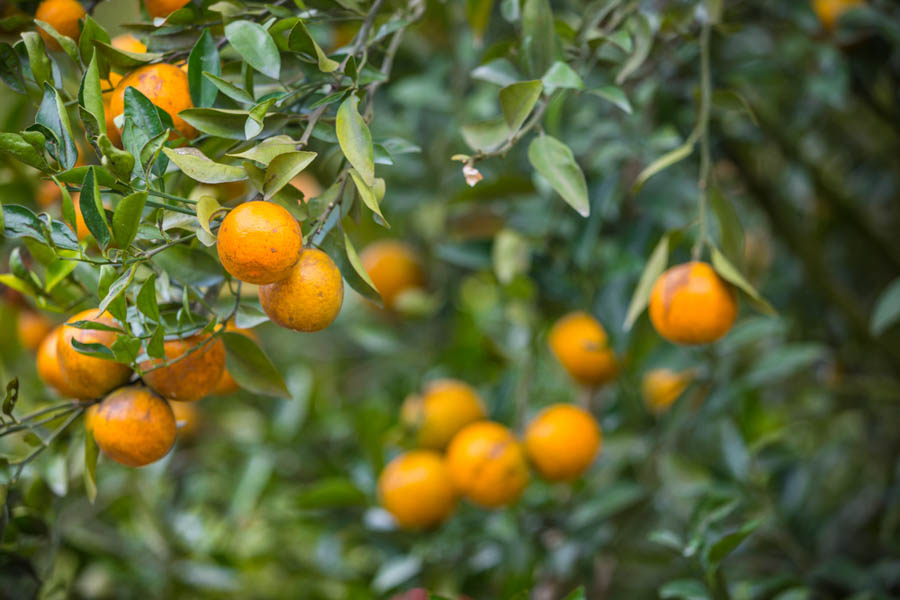Why Are Leaves Curling on My Orange and Lemon Trees?

GardenZeus receives commissions for purchases made through links in this post. There is no additional cost to you.
Why Are Leaves Curling on My Orange and Lemon Trees?
Curling leaves are common on citrus trees and may result from one or more causes. Here are a five of the most-common:
Drought Stress: Insufficient soil water is probably the most-common general cause of curling citrus leaves. This can occur at any time of year, but is most common with trees in areas that aren’t regularly irrigated, during long periods without rainfail, and during hot weather. The upper left of the picture above shows leaf curl typical of drought stress. Water slowly and deeply at the driplines of the trees (on the surface of the ground below the edges of the canopy), preferably using chlorine-free water. Mature citrus trees in dry soil may need 12 hours or more of watering with a hose on a slow trickle at one or more locations around the trees to resolve drought stress. An organic mulch may help retain soil moisture and improve soil over time. Cover most of the soil surface under citrus trees with up to 2 inches of coarse mulch, extending past the driplines, but avoid placing mulch within a foot of the trunk of mature trees, and keep mulch several inches away from major surface roots.
Cold Weather: Citrus leaves may curl in response to cold weather. Many types of citrus withstand overnight frost or short periods of frost. Blossoms and fruit of most citrus are sensitive to frost. Dead leaves that still attached at the tops of trees and outer canopies after periods of cold weather may indicate frost damage. Cover canopies with cloth or plastic sheets overnight to protect them from mild frost. Most types of citrus trees recover well after minor frost damage.
Sunburn: Curling citrus leaves with yellow, brown, or grey spots may be sunburned. This usually occurs on outer leaves that are exposed to the longest periods of direct sunlight during warm-to-hot weather, usually on the south and west sides of trees. A section or two of sunburned leaves usually doesn’t pose a serious problem for mature trees. Provide shade. It may be beneficial to allow sunburned leaves to persist on the tree until weather cools. If a layer of sunburned leaves is removed, the leaves beneath them may also become sunburned.
Sucking Insects: Sucking insects such as aphids, whiteflies, mites, and psyllids, including the Asian Citrus Psyllid, feed on citrus leaves by sucking out plant juices. Check the undersides of leaves for signs of infestation. If infestations are caught early, sucking insects can often be removed or discouraged using a strong stream of water. Eliminate Argentinian ants in areas around infested citrus trees. The ants may fend off beneficial-insect predators in order to harvest the sugary honeydew excreted by sucking insects. Sticky traps, insecticidal soaps, and neem oil may help to reduce populations of insect pests. Trees infested by Asian Citrus Psyllids may become infected by a bacterial disease known as Huanglongbing (“HLB”), for which there is no known cure.

Asian citrus psyllids populate the back of this citrus leaf. Used with the permission of californiacitrusthreat.org
Gardeners who believe they may have a citrus tree infested with Asian citrus psyllids or infected with HLB should contact California Citrus Threat Citrus Threat and Disease Prevention Program.
Citrus Leafminers are tiny moth larvae that tunnel through young, new citrus leaves, which may cause citrus leaves to become twisted, distorted, and/or curled. The larvae also roll the edges of citrus leaves around themselves when they pupate. Mine trails are often easily identifiable. Citrus leafminers tend to cause the most harm to young trees with new leaves. Generally the best way to manage citrus leafminers is to do nothing! In most causes only the newest leaves are affected, and damage is not usually sufficient to cause much reduction in fruit yield or long-term harm to trees.
Don’t know you GardenZeus climate zone? Click here.
Other articles of interest:
Year-Round Oranges in Mild Winter Areas of California
Are Your Oranges Ripe? Or Not?
Orange Trees: Should They Have Companion Plants?
This is an updated version of an article originally published on January 14, 2018
Felco pruners are an essential garden tool. They can be used for removing dead branches on your citrus trees and for general garden pruning and maintenance.


